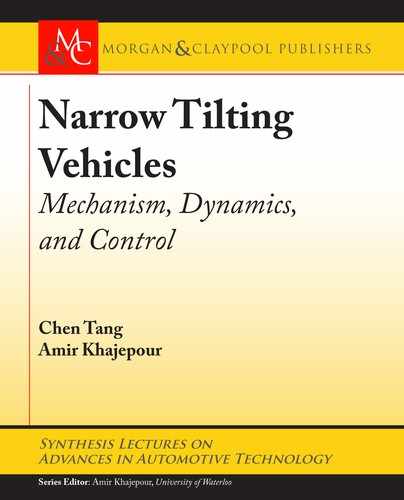
38 4. TILTING VEHICLE CONTROL
tilting control grows quickly, while the dark area, which denotes the situations with maximum
tilting angles, shrinks to the upper right corner. For a conservative case when the desired LTR
index is zero (Figure 4.3a), tilting actuators are activated all the time. e envelope-based tilting
control strategy (Figure 4.3b–d) is only expected to deal with rollover tendency at higher speeds
with harsher maneuvers.
Although a higher threshold value helps to improve the energy efficiency, determination
of a proper threshold LTR
lim
also needs to consider conflicting factors like safety margin, riding
comfort, and driving sensations. All tuning for the threshold need to be validated by driving
simulators [71] or tests to achieve a balanced solution. Drivers might also be allowed to ad-
just such settings from the dashboard to meet their specific driving style and the fuel economy
preferences.
4.3.4 ROLL ENVELOPE AS STATE CONSTRAINTS
e previous two sections demonstrate the possibility of implementing the threshold of roll
envelope as steady-state torque inputs or motion states. e desired control torque or tilting
angle in the form of Eqs. (4.3) and (4.4) considers the desired LTR index threshold as a tunable
parameter, which compromises between the energy consumption and safety margin improve-
ments [47]. However, since both expressions are derived under the steady-state assumptions,
the transient behavior is not captured. To improve roll control performances, especially under
harsh scenarios, a full consideration of both steady-state and transient performances is desired.
With the LTR index written in the form of Eq. (3.14), the prediction of rollover tendency
is possible with available roll states measurements and estimations [72]. Furthermore, with the
given tilting moment inputs .U
r
/ and measured disturbances .W
r
/, the LTR index can be rep-
resented as a linear combination of roll states .X
r
/. If plotted in the roll phase plane .
P
/,
the contour of LTR indices is a set of sloped lines determined by the suspension properties. Two
sets of LTR-index boundaries are illustrated in Figure 4.4. e sloped dash-dot lines stand for
the desired roll envelope .e.g., LTR
lim
D 0:5/, while the dash lines represent the hard boundary
for the rollover situation .LTR
lim
D 1:0/. Horizontal lines in the phase plot represents the roll
rate limits
P
lim
derived from actuator restrictions as well as passenger comfort requirements.
Compared with roll control approaches which track either zero roll angle (y-axis in the
phase plane) or zero rollover index (the line with LTR
lim
D 0:0), the envelope approach saves the
control effort by only maintaining the roll states within the envelope area to achieve the required
level of stability.
e equilibrium point for the roll dynamics can be solved from Eq. (3.9) as
ss
D
m
s
h
s
a
y
C T
x
K
m
s
gh
s
: (4.6)
When there are no lateral disturbances nor control torques, the passive system should
converge to the origin with various initial states located on the rollover index boundaries, as

4.3. ENVELOPE-BASED ROLL STABILITY CONTROL 39
1
0.5
0
-0.5
-1
1
0.5
0
-0.5
-1
-0.2 -0.1 0 0.1 0.2 -0.2 -0.1 0 0.1 0.2
dφ (rad/s)
dφ (rad/s)
φ (rad) φ (rad)
(a) Without disturbance (a
y
= 0) (b) With disturbance (a
y
= 0.5g)
Figure 4.4: Open-loop vehicle phase portrait in roll plane.
shown in Figure 4.4a. However, as the lateral acceleration increases, the equilibrium point will
move along the horizontal axis which makes the vehicle less stable, as shown in Figure 4.4b.
Some trajectories cross the boundary of rollover index thresholds, which should be mitigated by
proper controls.
It should also be noted that the static equilibrium point shown in Eq. (4.6) might not be
a good measure to determine whether to activate the roll control. As can be seen in Figure 4.4b,
although the static equilibrium point for this case stays inside the desired envelope, there might
be transient dynamics causing the states to leave the safe envelope. A model-based approach is
adopted to predict the development of LTR index during run-time and activates the envelope
control accordingly. e safe roll envelope defined and visualized above can be written as
M
ro
X
.
k
/
r
C N
ro
U
.
k
/
r
L
ro
; (4.7)
where
..................Content has been hidden....................
You can't read the all page of ebook, please click here login for view all page.
